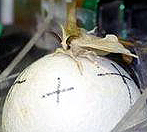Who knew silkmoths were such pickup artists?
Scientists at the University of Tokyo recently provided one of the insects with a tiny, two-wheel robotic ride—and it promptly steered its way toward a sex pheromone usually given off by a female mate.
The results—covered in the latest issue of Science Daily and originally published in the February 6 edition of the journal Bioinspiration and Biomimetics—will be used in future attempts to create autonomous robots that can track down the smells and find the sources of environmental spills and leaks when fitted with highly sensitive sensors.
The male silkmoth was chosen as the “driver” of the robot (see the video below) due to its characteristic mating dance when reacting to the sex pheromone of the female. Once the male is stimulated by the pheromone, it exhibits a distinctive walking pattern—straight-line and zigzagged walking, consisting of several turns, followed by a loop of more than 360 degrees.
Lead author of the research, Dr. Noriyasu Ando, said, "The simple and robust odor tracking behavior of the silkmoth allows us to analyze its neural mechanisms from the level of a single neuron to the moth's overall behavior. By creating an 'artificial brain' based on the knowledge of the silkmoth's individual neurons and tracking behavior, we hope to implement it into a mobile robot that will be equal to the insect-controlled robot developed in this study."
Methodology
The Tokyo researchers attached the silkmoth to a free-moving polystyrene ball at the front of the robot, which was used for overall control—much like the ball in a computer mouse.
Two 40-millimeter (mm) fans were attached at the front of the “vehicle,” to waft the pheromone-containing air to the on-board moth. Researchers used the fans to mimic the wings of the silkmoth, which flap to generate air flow across its antennae.

A close-up of the silkmoth suitor steering the robotic ball
An 1,800-mm wind tunnel was used in the experiments; the pheromone and robot were placed at opposite ends. Fourteen silkmoths were subjects in the study and all of them were able to successfully guide the robot toward the source.
The researchers also introduced a turning bias to the experiments, changing the power of one of the robot's two motors so it veered toward one side when moving. This required the silkmoth to adapt and change its behavior in order to reach the pheromones.
"The best way to elicit adaptive behaviors of insects is to put them into extraordinary situations. The turning bias in our study is analogous to a situation in which we try to ride unbalanced bicycles. We need training to ride such bicycles smoothly, but the silkmoth overcomes the situation with only simple and fast sensory-motor feedbacks," said Dr. Ando.
Edited by Braden Becker
